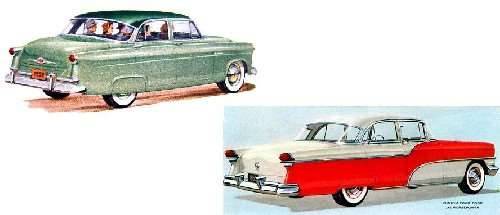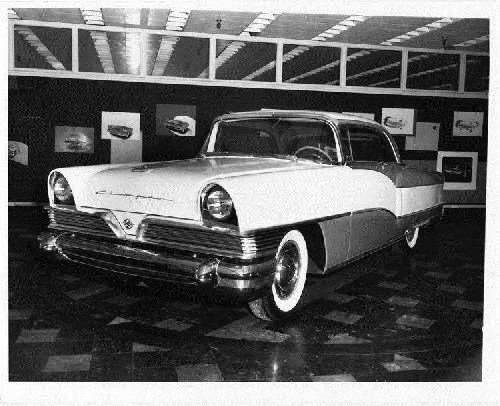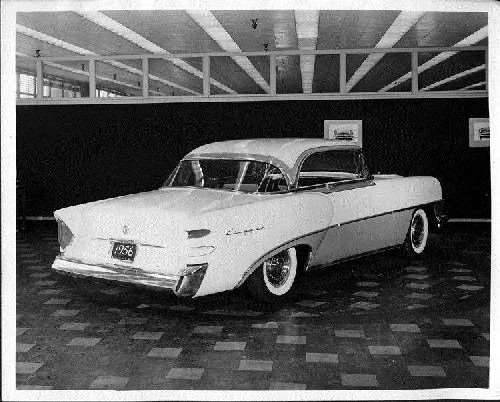|
Re: What SINGLE factor MOST contributed to the demise of Packard?
|
||||
|---|---|---|---|---|
|
Home away from home

|
Another factor that may have led to Packard's demise is how the company portrayed itself. This ad from 1937 shows the company in its full glory. No car is shown nor is one needed. Of course, such advertising would have been much less effective in 1951 because it is predicated on having a top drawer car that recognizes no superiors.
http://www.oldcaradvertising.com/Packard%20Ads/1937/1937%20Packard%20Ad-05.html Fast forward to today and we see Cadillac coming to the same realization re: luxury car buyers and what motivates them. I like it. http://www.bloomberg.com/news/articles/2015-02-19/cadillac-has-a-new-brand-strategy-and-it-involves-subtlety-and-fashion
Posted on: 2015/2/22 18:29
|
|||
|
||||
|
Re: What SINGLE factor MOST contributed to the demise of Packard?
|
||||
|---|---|---|---|---|
|
Home away from home

|
The Jet and Clipper tailights and backlight were somewhat similar, could probably have lived together happily in the 1955 Hudson showroom as a Jet and Hornet. Or perhaps the 122" Clipper could have become the Wasp, with standard Hudson 308 Six or optional Packard 320 V8, and a new 127" wheelbase car with the Patrician's longer body readied as a Hornet with V8 only. The challenge would have been tying the Clipper rear fenders and tailights to the Patrician body, which might have involved additional tooling. Ditto the Executive, it needed the Patrician's catherdral tailights and side trim. One thing is for sure, Nance would have finally gotten his long wanted Depression-proof little entry car, the Jet being one good redesign away from taking off. No more need to contemplate buying Austin or the like, and the Jet would have come in handy in 1958 when the recession finally came. On this, Nance had good vision.
Posted on: 2015/2/22 20:32
|
|||
|
||||
|
Re: What SINGLE factor MOST contributed to the demise of Packard?
|
||||
|---|---|---|---|---|
|
Home away from home

|
<i>Merger with Hudson would have been a tougher road particularly since the ink would not have been signed until say, January 1, 1954 which would have been the earliest realistic date given Barit's intractable independence (he only began talking merger when the Jet failed). By then Hudson was losing money by the millions, had no clue how to design an attractive car and was facing (and someone please correct here if wrong) a loss of Jet body stampings because Murray was getting out. The 1955 Hudsons would probably have become "Packsons" or "Hudards" i.e. Clippers with a Hudson face job, or perhaps they would have been the actual Clipper, Nance deciding he didn't need Clipper now that he had Hudson.</i>
On the issue of the Jet, Murray did not exit the body business until the Willys Aero was dropped in 55, so bodies would have been available for the Jet at least until that time, close to a year later than when the Jet was actually killed. The question would be if there was enough Jet volume to keep the unibody line at Jefferson running at an economic pace. I suspect a sub 20,000/yr rate says "no". <i>One unknown would have been whether Nance would have been as cold-hearted as Mason in shutting down Hudson operations. The warmer his heart, the more Hudson would have bled it.</i> Nance was a job hopper. I don't see much indication of his loyalty to anyone but himself. He would have had no problem closing Jefferson, and some of the workers would have probably been taken on at EGB. The Hudson body plant, a few blocks north on Conner, would continue with it's existing staff, using Packard tooling moved from Briggs. They would not have had Studebaker's appalling productivity issues, nor the wildly oversize and inefficient South Bend works, nor the split board. Getting the merger done in time for the 54 model year would have had the advantage of that being the year Clipper styling started diverging from Packard. The unique Clipper taillights and instrument panel being reassigned to the Hudson, with the 308 for power and a front clip like what the 54 Hornet actually wore, while the Clipper carried senior Packard styling cues. If the Hudson was accepted in the market, then start phasing out the "mid priced" Clipper in favor of the Executive, essentially a short wheelbase Packard, trimmed nearly as well as the senior cars, while the Hudsons see the 308 phased out in favor of the smaller version of the Packard V8. Even if the Clipper based Hudson was rejected by the market, Packard would have still picked up 7,000 dealers, existing clientele, existing service parts business and the body plant.
Posted on: 2015/2/23 2:32
|
|||
|
||||
|
Re: What SINGLE factor MOST contributed to the demise of Packard?
|
||||
|---|---|---|---|---|
|
Home away from home

|
Quote:
Actually, by reports the Jet's backlight was copied from Ford and the taillights copied from Olds. I had always thought the Jet looked OK in photos. Then I saw one in the metal. OMG that is one tall, narrow car. It just looks bogus. Even in it's first year, Jet sales were far below first year sales for the Aero and Henry J, the J being no styling masterpiece either. Keeping it alive after moving the senior Hudsons to the Clipper platform would probably be impossible as it would involve keeping Jefferson assembly open for a tiny production flow, and keeping the 202 engine line going for an equally tiny production flow. I wouldn't bother with a 127" wb Hudson as that would move the Hudson brand against the senior Packards. We know how that worked out for Chrysler and DeSoto. I'd keep both the Hornet and Wasp names on the 122" wb, differentiating them with trim and powertrain, phasing the V8s into the Hornets first. I wouldn't bother shortening the existing Clipper platform the way the Wasp was shortened due to cost and an already rather old platform. A shorter wheelbase Wasp might be a possibility when a new platform became available.
Posted on: 2015/2/23 2:45
|
|||
|
||||
|
Re: What SINGLE factor MOST contributed to the demise of Packard?
|
||||
|---|---|---|---|---|
|
Home away from home

|
"Hackard" styling. Starting in 55, I would use this proposal for the grill. I think the Hudson triangle would fit in the split in the grill just fine. Rather than the welded on and lead filled headlight hoods like Packard used, I think I would give the Hudson's bolt on hoods, like Mercury used, for reasons of cost and differentiation.
I favor the version of bodyside trim in the second pic, to pay homage to the preceding stepdown Hudsons. One other point of differentiation: I would keep Torsion-Level a Packard exclusive. I like the dive/squat characteristics of the trailing arm setup the T-L suspension used, so I would use the trailing arms on the Hudson, but with coil springs.
Posted on: 2015/2/23 2:52
|
|||
|
||||
|
Re: What SINGLE factor MOST contributed to the demise of Packard?
|
||||
|---|---|---|---|---|
|
Home away from home

|
The 4-way merger proposed in the early 1950s was NO myth.
The May 17, 1952 issue of Business Week devoted a full-page to Nance joining Packard. The headline read "Nance's Idea: Merge Packard." The newsweekly reported that "Nance intends to make Packard the nucleus of a big new auto company - big enough to join the Big Three, General Motors, Chrysler and Ford - in a new Big Four. Nance's idea is to merge Packard with one or more of the other independent auto producers, most likely Nash-Kelvinator. It was on the understanding that he could tackle something like this that Nance took the Packard job." "Putting Packard together would be one way to cure some of the problems," Business Week concluded, "as well as add to the number of dealer outlets and widen the line. Such a union might sound attractive, too, to an outfit like Nash. If not, there are other possibilities. The Detroit Athletic Club bar has cooked up many a merger that never came off. But no one should be surprised to learn any day that Hudson, Studebaker, Nash, Packard or Willys really was involved in a merger made up of some combination of those named." So - what Business Week had guessed at was being talked about at the Detroit Athletic Club, as well as other area watering holes. And it had been "received favorably," Business Week reported, "by the powers-that-be, including such big shareholders as the Newberrys and the Macauleys."
Posted on: 2015/2/23 23:01
|
|||
|
||||
|
Re: What SINGLE factor MOST contributed to the demise of Packard?
|
||||
|---|---|---|---|---|
|
Home away from home

|
the grand merger idea was indeed no myth, only the probability of it actually happening with egos as large as James Nance and George Romney was a myth. Both men would never accept anything less than the number one slot as head of any combined entity. George Mason played James Nance like a fiddle by talking the merger informally to get needed parts from Packard, Nance took the bait hook line and sinker and sold Nash Packard's Ultramatic transmissions and V8 engines, and they were used in 1955 Hudsons and Nashes. When Mason's successor, Romney, gave Nance the cold shoulder on continued merger talks, Nance stiffed AMC and Packard did not reciprocally purchase parts from AMC as promised. AMC then quickly built their own V8 engine and stopped buying parts from Packard. There was no marriage let alone engagement. Just corporate flirting that went really nowhere.
Posted on: 2015/2/24 0:45
|
|||
|
||||
|
Re: What SINGLE factor MOST contributed to the demise of Packard?
|
||||
|---|---|---|---|---|
|
Home away from home

|
Nance's idea is to merge Packard with one or more of the other independent auto producers, most likely Nash-Kelvinator. It was on the understanding that he could tackle something like this that Nance took the Packard job."
Well now. That squares with what Nance told Langworth in 73, including that his joining Packard was with the understanding that he would execute the mergers. Nance told Langworth he would not have taken the job just to run Packard. As I recall from the Langworth Hudson book, Nance said he was told of the "grand plan" by Hugh Ferry when he interviewed for the Packard job. Supposedly Ferry was tight with a banker that was tight with Mason and had heard of the plan via that grapevine. Doesn't explain why, then, Nance and Packard blew off merger proposals from Hudson and Nash, especially if Mason was the source of this grand plan.
Posted on: 2015/2/24 2:04
|
|||
|
||||
|
Re: What SINGLE factor MOST contributed to the demise of Packard?
|
||||
|---|---|---|---|---|
|
Home away from home

|
George Mason played James Nance like a fiddle by talking the merger informally to get needed parts from Packard, Nance took the bait hook line and sinker and sold Nash Packard's Ultramatic transmissions and V8 engines
From some accounts, Nash had put some money into the development of the Packard V8, so access to the engines was part of the development deal. Romney complained loudly about the cost of the Packard powertrain components. When Packard went to AMC for bids on some stamping work, AMC's prices were stratospheric, compared to what Packard could get elsewhere. Then there was the event when AMC approched S-P about buying Studebaker V8s to use in the Statesman, which was woefully underpowered with the 196. And S-P eyed the AMC 196 for the Champion as it was more powerful than the old Champion 6. The proposal to swap V8s for 6s was killed by higher ups at both companies. Nance didn't want to sell the V8s, and Romney said they were going to sell so many Ramblers that they would have no 196s to spare. As you said, gigantic egos at play, more interested in advancing themselves than in doing the pragmatic things to keep the companies going.
Posted on: 2015/2/24 2:15
|
|||
|
||||

 (37.85 KB)
(37.85 KB)









